October 21, 2016
Air Date: October 21, 2016
FULL SHOW
SEGMENTS

The Libertarian Choice
View the page for this story
Libertarian presidential nominee Gary Johnson and his running mate, Bill Weld are both former Republican governors who have rebadged themselves as Libertarians. Chip Knappenberger, a scientist with the Libertarian think tank, the Cato Institute, joins host Steve Curwood to discuss how the former New Mexico and former Massachusetts chief executives would approach environment and energy issues if they governed America. (09:25)
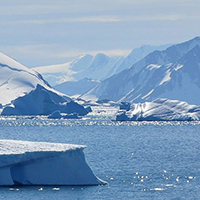
Beyond the Headlines
/ Peter DykstraView the page for this story
This week in his Beyond the Headlines analysis, Peter Dysktra gives host Steve Curwood an update on the toxic effects of some natural gas and mercaptan accident sites on a southern black community today. He also notes promising global conservation agreements, including a possible breakthrough in the Antarctic Ocean, and they recall the coal mine waste disaster in the Welsh village of Aberfan. (04:00)
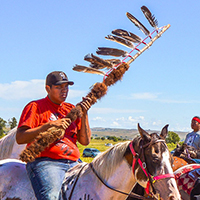
Standing With the Standing Rock Sioux
/ Sandy TolanView the page for this story
A rash of arrests at the Standing Rock demonstrations points to rising tensions between North Dakota state officials and the thousands that have allied themselves with the Standing Rock Sioux Nation to protest the construction of the Dakota Access Pipeline through ancestral lands and sources of water. Reporter Sandy Tolan visited the encampment that serves as a home base for the protestors, and explains to Living on Earth Host Steve Curwood that claims of protester “riots” are unfounded, based on what he observed. (10:50)
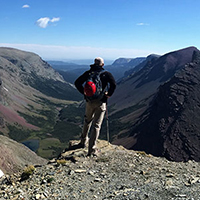
The Place Where You Live: Glacier National Park
/ Björn BeerView the page for this story
Software executive and writer Björn Beer describes the breathtaking beauty of Montana’s Glacier National Park and mourns the impending loss of the park's namesakes. It's the latest installment in Living on Earth's collaboration with Orion magazine that gives a voice to Orion's longtime feature in which readers write about the places they call home. (05:45)
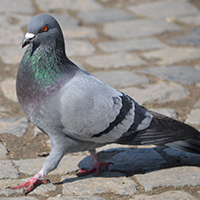
Science Note: Pigeons Flag Lead Pollution
/ Jay FeinsteinView the page for this story
Lead exposure, even at low levels, affects brain development, memory and social skills in children. But as Jay Feinstein reports in this week’s Note on Emerging Science, lead also affects urban wildlife, and a new study suggests pigeons may be good indicators for environmental lead levels. (01:45)

The Lion in the Living Room
View the page for this story
America is a nation of cat-lovers, but the reality is that they don’t always bother to love us back. They don’t need to, as we provide for them anyway, according to a new book, The Lion in the Living Room. Author Abigail Tucker and host Steve Curwood discuss how housecats came to thrive in a human-dominated world, and how, in reality, we didn’t tame them, they tamed us. (12:45)
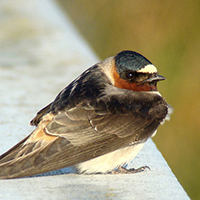
BirdNote: Swallows in Winter
/ Michael SteinView the page for this story
Fall brings colorful leaves and departing swallows. As Michael Stein explains in today’s BirdNote, you’ll have to head down to Central and South America yourself if you want to hear their twittering over your head before next spring. (02:05)
Show Credits and Funders
Show Transcript
HOST: Steve Curwood
GUESTS: Chip Knappenberger, Bjorn Beer, Abigail Tucker
REPORTERS: Sandy Tolan, Jay Feinstein, Michael Stein
[THEME]
CURWOOD: From Public Radio International, this is Living on Earth.
[THEME]
CURWOOD: I'm Steve Curwood. Energy and environmental policy...when it comes to the Libertarian Presidential ticket, the platform is brief.
KNAPPENBERGER: Libertarian views on federal government in general sort of are akin to maybe what Mies van der Rohe's views are on architecture, which is "less is more". So that is sort of summed up as well, I think, in environment and energy policy put out by Gary Johnson that they're running this time.
CURWOOD: Also, native Americans continue their stand against the Dakota Pipeline project on sacred lands and gather broad sympathy.
GOLDTOOTH: We're getting support from all over the world, and they're seeing something here that gives them inspiration to also re-evaluate their own relationship to their community, their relationship to their families, and really question this power construction called capitalism.
CURWOOD: Those stories and more this week, on Living on Earth. Stick around.
[NEWSBREAK MUSIC: Boards Of Canada “Zoetrope” from “In A Beautiful Place Out In The Country” (Warp Records 2000)]
[THEME]
The Libertarian Choice

Former Governor of New Mexico Gary Johnson is this year’s Libertarian Party nominee for President of the United States. (Photo: Gage Skidmore, Flickr CC BY-SA 2.0)
CURWOOD: From the Jennifer and Ted Stanley Studios at the University of Massachusetts Boston and PRI, this is Living on Earth. I’m Steve Curwood. As the US national elections approach we wrap up our review of the environmental records and plans of the presidential candidates with a look at the two Republicans who have rebadged themselves as Libertarians, former Governors Gary Johnson and Bill Weld. Former New Mexico Governor and Libertarian presidential nominee Gary Johnson has said there is “no compromise when it comes to clean air, clean land or clean water,” sentiments echoed by Libertarian vice presidential nominee and former Massachusetts Governor Bill Weld. To drill down on their views we turn to Chip Knappenberger, Assistant Director for the Study of Science at the Cato Institute. Welcome to Living on Earth.
KNAPPENBERGER: Thanks, Steve, glad to be here with you.
CURWOOD: Now, why do you think that the Johnson and Weld campaign has gone for a bare-bones approach, at least as far as their official platform goes when it comes to energy and environment?
KNAPPENBERGER: Sure, I think Libertarian views on federal government in general sort of are akin to maybe what Mies van der Rohe's views are on architecture, which is "less is more". So that is sort of summed up as well, I think, in environment and energy policy put out by Gary Johnson that they're running this time. So he doesn't have a lot to say about it. I think the the Libertarian 2016 party platform has 126 words dedicated to energy and environment, where the other platforms from the other parties are pages and pages of explanation out there. So, it's pretty much a hands-off approach. So he doesn't have a whole lot to say about it.
CURWOOD: Give me the textbook Libertarian position say on polluted water. How would you deal with that as a Libertarian?
KNAPPENBERGER: Well, the Libertarians are big on property rights and individual property rights, and so if someone is trampling upon your individual rights you can litigate that. So I think on issues like pollution, especially when you can identify someone who's causing the pollution and then a harm that comes to you, they prefer that you litigate that with existing laws in the courts. Now, air pollution is a much trickier thing for Libertarians to deal with, and there is no Libertarian stance on how you do that, and various Libertarian scholars have different opinions about how to handle these more nebulous things like air pollution where we all kind of contribute to it.
CURWOOD: Yeah, and of course, that was takes us right to the question of climate disruption. What's the Libertarian perspective on dealing with climate issues?

Gary Johnson’s running mate is Bill Weld, another former governor, who held office in Massachusetts in the 1990s. (Photo: Darron Birgenheier, Flickr CC BY-SA 2.0)
KNAPPENBERGER: Well, I am a climate scientist that works for the Cato Institute, which is a Libertian think tank. My views of climate science are more summed up in the word "lukewarming," that humans are impacting the climate through emissions of greenhouse gases. Those emissions are having impacts but those influences are not as large as being advertised by some of the folks who are more activist in wanting to have government involved in energy and environmental issues. I have a new book out, it's called "Lukewarming" and it's about the science that I think supports that notion that the urgency is not there as far as some people see.
CURWOOD: Now, what would be Governor Johnson's plans for existing environmental regulatory structures such as the Environmental Protection Agency?
KNAPPENBERGER: Sure, I think he has come out and said that the Environmental Protection Agency serves a useful role, especially in protecting water and certain types of air pollution. I mean, if you're emitting smoke out of your smokestack that's a particulate matter, or something like that, you can put a scrubber on it and clean up those emissions. And the EPA's role in that is probably an essential one. I think there's some thought that the EPA is overstepping some of its bounds of the current administration, and Gary Johnson would probably want to roll that back a little bit. The Republicans have put forth the idea that they would disband the EPA or really roll it in a lot, and I don't think he shares those views at all.

Johnson also ran for president under the Libertarian banner in 2012. (Photo: Gage Skidmore, Flickr CC BY-SA 2.0)
CURWOOD: Now, Governor Johnson's environmental platform states, and I'm quoting here, "Is the climate changing? Probably so. Is man contributing to that change? Probably so." What about his Libertarian philosophy prevents him from taking, say, direct actions to reduce carbon emissions?
KNAPPENBERGER: Well, one of the fundamentals of Libertarian philosophy is they don't particularly like to raise taxes. And so, there's the notion that some folks are saying that there's a Libertarian way to deal with climate change and that is through a carbon tax. Now, Governor Johnson flirted with the carbon tax back in late August or so for a couple of days, and by the end of the week he came around to thinking, it seems good in theory but he's thought through it, and he doesn't think it's going to work well in practice. And that I should say, Steve, is a revenue neutral carbon tax, where you put a tax, you but a price on carbon, and then you give that back through tax cuts or some other sort of way or giving it back. And that's something I think he thought was a Libertarian approach to the issue; however, in the real world that revenue neutral carbon tax probably isn't going to play out very well.
I think we see that happening in Washington State right now where initiative 732 is put before the people as a carbon tax that they are going to vote on. It's a revenue neutral carbon tax, and it's not sharing much support from the left because they sort of think well, we've gone through all the trouble of raising this money, we should use it to promote green initiatives and energy efficiencies and sort of things like that, and they don't want to give the money back. I think that's where probably Governor Johnson has drawn the line is, I think he said, "I've never raised taxes. I don't plan on doing it now."
CURWOOD: Now, as I understand it, Governor Johnson and Governor Weld want the free market to determine the best energy sources for United States. So, in your view, what would our energy portfolio look like down the road if this were to happen?
KNAPPENBERGER: I think that they have come out and said that they would like to just do away with all subsidies for solar, wind, for fossil fuels. So I think they would just level the playing field, if you will, from everybody and if you recognize that, which they do, that humans are causing climate change through carbon dioxide emissions, I think the solutions to those emissions and the solution to that potential issue is technological innovation and adaptation, is how I see it.
CURWOOD: Now, what is Governor Johnson's view on the Paris Climate Agreement and also the Obama administration's Clean Power Plan, which is meant to help the US follow through on the Paris restriction commitments that have been made internationally?
KNAPPENBERGER: Sure, Steve. As as we started off talking here, Governor Johnson has not said a whole lot about this stuff, so I can speculate what that might be, but I have not heard him really discuss it very much. I can't believe he would be for the Clean Power Plan, so I would imagine that under his presidency he would not put a whole lot of efforts to defending the Clean Power Plan in front of the Supreme Court, for instance.
When it comes to Paris, again, what would he do about that is an interesting question. Probably he would not be overly enthusiastic about it, and would probably let things slide in terms of the commitments that we have to it. The commitments only being that we will attempt to try to reduce our emissions in some ways. So, I don't think he's against attempts to reduce emissions. I think he's against heavy-handed, command-and-control federal policies to reduce emissions.
Look, business as usual is leading to carbon dioxide emissions in the United States. Natural gas fracking, for instance, and energy efficiencies are leading to less CO2 emissions, and the role that the federal government has had in that has not been huge, so you can produce new technologies and innovate without a big role of federal government. And so, I think even if you took some of EPA's powers and reeled that in a little bit, you would still see at least a leveling off if not a decline of CO2 emissions from US. I don't think he has to do a whole lot in order to keep the current decline happening.

Chip Knappenberger is an assistant director of the Center for the Study of Science at the Cato Institute, a Libertarian think-tank. (Photo: Chip Knappenberger)
CURWOOD: So, what do you understand about Governor Johnson's views on the natural resources that the federal government has in hand, in particular the national parks and public lands that are iconic and really held for us all?
KNAPPENBERGER: If you take Libertarianism to its extremes, it leads to some sort of notion that we should sell off all our national parks and our national lands, but when it comes to our national parks, even from his webpage, it says, “We need to stand firm to protect our environment for the future generations, especially those designated areas of protection like our national parks”. So, I think he's pretty much out front saying that our national parks are an important part of our national heritage, and he plans on protecting those areas.
CURWOOD: Chip Knappenberger is a climate scientist and Assistant Director for the Study of Science at the Cato Institute. Thanks so much for taking the time with us.
KNAPPENBERGER: Sure. It was very good talking to you today, Steve.
Related links:
- Gary Johnson presidential campaign
- Libertarian candidates’ environmental platform
- Libertarian party official website
- Chip Knappenberger profile
Beyond the Headlines
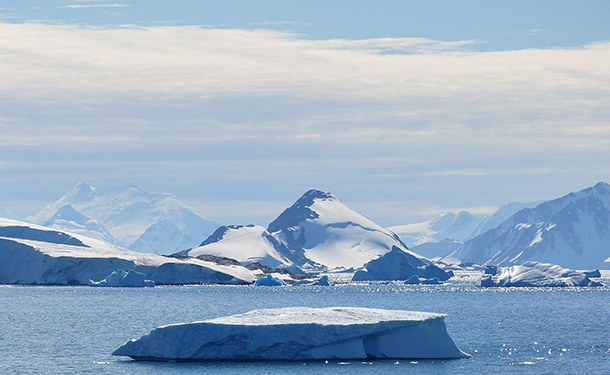
The Convention for the Conservation of Antarctic Marine Living Resources (CCAMLR) began meeting for two weeks of talks concerning the protection of large swaths of Antarctica. There are hopes that Russia will agree to protecting these areas. (Photo: Vincent van Zeijst, Wikimedia Commons CC BY-SA 3.0)
CURWOOD: We’ll check into the world beyond the headlines now with Peter Dykstra of Environmental Health News, EHN.org and DailyClimate.org. He’s standing by in Conyers Georgia. Hello there, Peter.
DYKSTRA: Hi, Steve. Let’s start and finish this week with some news that might make folks angry, but there’s some potentially big good news that I’ll share in between.
CURWOOD: OK. Well, what’s the first angry news?
DYKSTRA: Remember the Aliso Canyon methane leak from last October?
CURWOOD: How could I forget? I mean methane leaked for months from a gas storage well, and they had to evacuate an entire community there near Los Angeles.
DYKSTRA: That’s right, Porter Ranch is an affluent, predominantly white outer suburb of L.A. The methane leak took four months to cap, 8,000 families had to leave their homes due to nausea, and nosebleeds, and vomiting from mercaptan, that’s the rotten-eggs-smelling chemical that’s added to gas to help detect leaks. It took months for the residents to return to some semblance of normal despite national media attention and a huge recovery effort. But let’s look at a poor, mostly African American community, Eight Mile, Alabama, another mercaptan accident site.
CURWOOD: Hmm. Let me guess. There’s much less enthusiasm to help this little town?
DYKSTRA: Yeah, they’ve been dealing with the same health effects from mercaptan not for a few months, but for eight years. Very little media attention, no Federal investigators swarming the place, no evacuations. In 2008, a lightning strike caused a pipeline leak, sending mercaptan into the air, soil and groundwater around Eight Mile. It caused the same health impacts as Aliso Canyon, and eight years later those health impacts remain. Local residents’ lawsuits over the spill remain unresolved.
CURWOOD: Eight years. So I guess some of those kids that were sick in Eight Mile eight years ago are sick young adults now. What’s next?
DYKSTRA: Well I promised you some good news: two of the most important conservation agreements have had meetings and some long-overdue progress this month. CITES, the Convention on Trade in Endangered Species, advanced some protections for endangered plants and animals as you reported a few weeks ago, and the Kigali meeting on climate will bring about restrictions on hydrofluorocarbons – HFC’s – a powerful source of greenhouse gases.
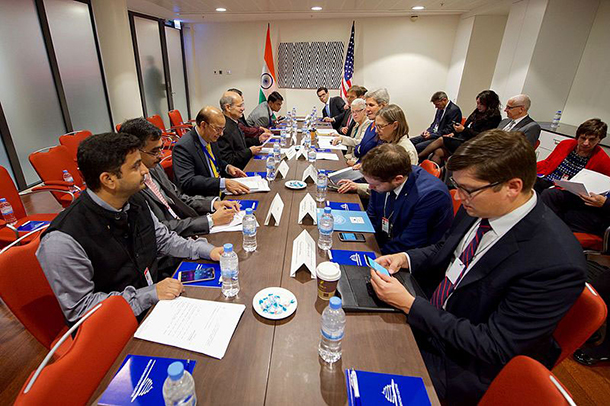
U.S. Secretary of State John Kerry and EPA administrator Gina McCarthy are among those who joined Indian Environment Minister Anil Dave in a negotiations session between the U.S. and India at the recent meeting in Kigali, Rwanda. The agreement reached there will restrict emissions of hydrofluorcarbons, or HFC’s, powerful greenhouse gases. (Photo: U.S. Department of State, Wikimedia Commons, public domain)
CURWOOD: Yeah, that is good news. The HFC agreement is huge.
DYKSTRA: Yeah, but I wanted to talk about a third big global agreement – one that happens to have a terrible acronym. Camel-R, the Commission for the Conservation of Antarctic Marine Living Resources. 24 nations plus the European Union, they’re in the middle of two weeks of talks that may result in huge marine protected areas in the Ross Sea and in East Antarctica. Russia has been the primary holdout, but President Vladimir Putin has declared 2017 to be the “Year of Ecology” in Russia. Antarctica has been a model of global cooperation for over sixty years, and, if the Russians come through, it could be one brief shining moment for Camel-R.
CURWOOD: Wait, did you just reference Vladimir Putin and King Arthur of Camelot?
DYKSTRA: I did, we’re talking big-time global cooperation here.
CURWOOD: OK. Well, hey, let’s move quickly to this week’s history lesson.
DYKSTRA: A horrible 50th anniversary in the Welsh countryside. Friday, October 21, 1966, at 9:15 in the morning, students had just settled into their classes in an elementary school in the village of Aberfan. Many of the kids’ fathers worked in the coal mine up the hillside from town. It had rained for several days, and a retaining wall holding back thousands of tons of coal mine waste uphill from the school gave way. It roared down and buried the elementary school. 116 students and 28 adults perished. A generation of kids in this small town, gone.
CURWOOD: That’s just awful. And to think we’re still coping with coal waste from mines and coal ash from power plants today.

A newspaper clipping from October 21, 1966 with early details of the colliery waste (coal mine waste) which buried an elementary school in the small town of Aberfan, Wales. The final death toll numbered 144. (Photo: Bradford Timeline, Flickr CC BY-NC 2.0)
DYKSTRA: We are, despite years and years of safety concerns and warnings. The local council in Aberfan also had complained about risks from the coal waste. The mining company had previously agreed to stop dumping its waste there, but it left a half century’s worth perched on the hillside above town.
CURWOOD: Thanks, Peter. Peter Dykstra is with Environmental Health News, that’s EHN.org and DailyClimate.org. We’ll talk to you again real soon.
DYKSTRA: OK. Thanks, Steve. We’ll talk to you again soon.
CURWOOD: And there’s more on these stories on our website, LOE.org
Related links:
- The eight-years-and-counting natural gas leak in the poor Alabama town of Eight Mile
- The Guardian: “Antarctic marine reserves deal within reach as Russia thaws environmental stance”
- About the deal to phase out HFCs reached in Kigali, Rwanda
- The Aberfan coal waste tragedy
[MUSIC: Diana Krall, “Almost Blue,” from The Girl In the Other Room, Elvis Costello, The Verve Music Group]
CURWOOD: Coming up...how a battle for human rights is converging with a battle for environmental protection in North Dakota. Stay tuned to Living on Earth.
ANNOUNCER: Support for Living on Earth comes from the Gordon and Betty Moore Foundation, and from a friend of Sailors for the Sea, working with boaters to restore ocean health.
[CUTAWAY MUSIC: Chris Botti, “My Favorite Things,” from Yo-Yo Ma and Friends - Songs Of Joy and Peace, Richard Rodgers and Oscar Hammerstein, arranged by Billy Childs, Sony BMG Music Entertainment ]
Standing With the Standing Rock Sioux
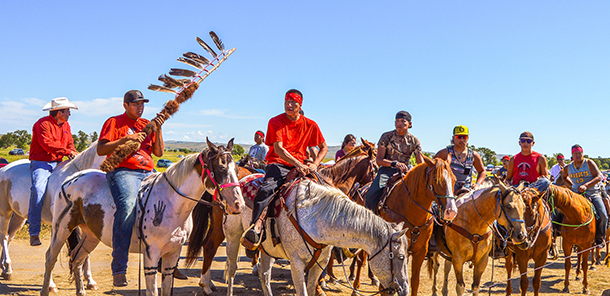
A rally led on horseback by the Standing Rock Sioux Nation and their allies. (Photo: Robert Wilson)
CURWOOD: It’s Living on Earth. I’m Steve Curwood. The latest flashpoint in the age-old disputes between the US federal government and Native American nations recently ignited over the Dakota Access Pipeline. It would link North Dakota’s Bakken Shale Fields with Illinois refineries and carry a half a million barrels of oil a day. But the project skirts the reservation of the Standing Rock Sioux Nation, and the Sioux claim construction has already destroyed sacred sites on public land and threatens to pollute water. The Sioux also say the Army Corps of Engineers’ decision to move the pipeline from its original path near the water supply of predominantly white areas to cross traditional Native sacred lands instead violates treaty rights and amounts to environmental racism.
When the courts rejected a Native suit to block construction, the Obama Administration stepped in and suspended work near a river, but much of the building continues. Meanwhile, Lakota and Sioux elders and activists have set up camp and are protesting the pipeline with drumming and chants and prayers.
[PROTESTERS DRUMMING AND CHEERING]
Reporter Sandy Tolan took his recording gear to the camp by the Cannon Ball River and joins us. Welcome to Living on Earth, Sandy.
TOLAN: Good to be here, Steve.
CURWOOD: So, you recorded these protests. What did they feel like?
TOLAN: Well picture a line of cars, almost 60, 70 cars long, all protesters moving slowly up a hillside toward where the path of the pipeline is, and then eventually coming up upon several dozen police vehicles, including a paddy wagon, an armored personnel carrier. The protestors, mostly Native American but also many supporters, they began praying and singing songs and dancing.
[SOUNDS OF DRUMS AND CHANTS]
There were a couple of dance groups and then the police moved in. You had almost 85 or more - perhaps more - police coming in. They basically said, “If you don’t move right now you’re on private land, you’ll be arrested.” Most of the protestors and the few journalists that were there, including me started moving out. I nearly got arrested. They said if I didn’t move within two seconds they would arrest me. Twenty-seven people were arrested that day, those who did not move and stayed around the teepee area. And strikingly, local prosecutors are bringing rioting charges against the demonstrators.
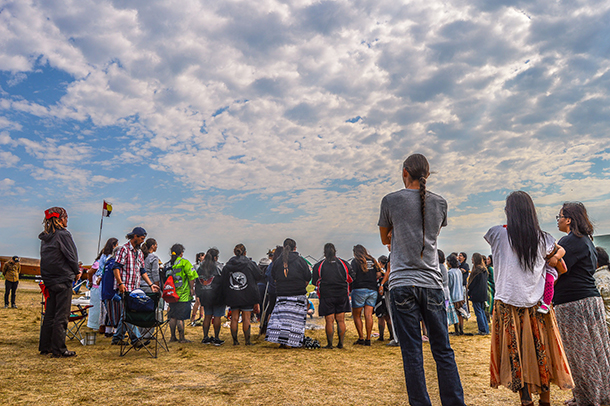
The Standing Rock campground, established to resist construction of the Dakota Access Pipeline, routinely holds morning prayer circles featuring traditional songs and chants. (Photo: Robert Wilson)
All the demonstrations I’ve seen are peaceful, and they all seem to be peaceful but the state seems to be ratcheting up the tension by bringing these rioting charges against peaceful protestors. They’re raucous, they're shouting, but they're peaceful. Meantime, here’s local sheriff Paul Laney.
LANEY: While some would like to say this was a protest, this was not a protest. This was a riot. When you have that many people engaged in that kind of behavior, inciting others to break the law, cheering others on as they do break the law, refusing to leave when they’re asked to leave, that’s not a protest.
CURWOOD: Sandy, is there anything to his claims?
TOLAN: Well I think what this really shows, Steve, is how much animosity there is from state officials at the protestors. The reservation has really been militarized. National guardsmen check vehicles at a highway checkpoint. The main protest camp is regularly surveilled by a light plane that circles overhead. There’s a helicopter that buzzes protestors regularly. There were multiple reports from encampment residents that I interviewed of surveillance drones and so-called “stingray” devices that vacuum personal data from cell phones. You know, at times I felt I was back reporting in the West Bank, and not in the Northern Plains, and Standing Rock Tribal Chairman David Archambault says, it’s not because of protesters that tensions have ratcheted up.
ARCHAMBAULT: It’s because of the behavior of the state that these tensions are heightened. They're the ones who put the blockade up, they're the ones who have low flying planes. They're the ones who bring in county sheriffs from all over. And they're the ones who use the terminology, right? They're the ones who use terminology “terrorist”. So, if there's a heightened level of confrontation, it's not because of what the demonstrators are doing when they -- when they walk down that road to address the construction that's going on.
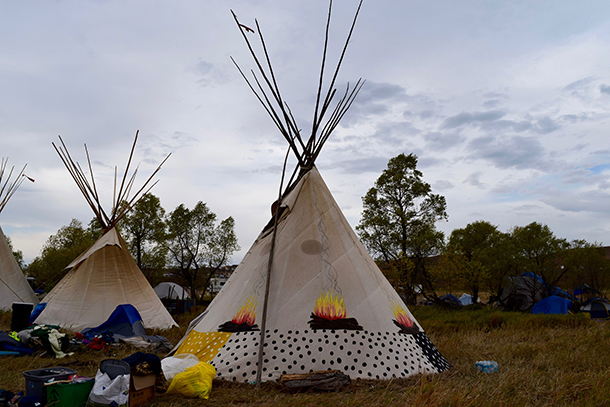
Tipis dot the landscape of the campsite. (Photo: Jacqueline Keeler)
TOLAN: It should be noted too that Archambault himself was arrested at a recent protest – and strip-searched. The chairman of the Standing Rock Sioux tribe was strip-searched. He stood naked as an officer checked his braid for weapons. One woman told Amy Goodman that she was strip-searched and forced to “squat and cough.” Add to these, the inflammatory rhetoric of local radio hosts. When I was there I repeatedly heard them call anti-pipeline protestors “terrorists”, and it’s clear to me anyway that the state has adopted a kind of scorched-earth policy against the anti-pipeline forces and just about any media at all sympathetic to them.
CURWOOD: Why is the state of North Dakota pressing so hard for this pipeline?
TOLAN: Well, you know, North Dakota, is almost like energy is a religion there, coal and oil in particular. North Dakota went all in on fracking about 10 years ago, roughnecks flooded to the Bakken oil formation in the northwestern corner of the state. Thousands of wells were drilled for fracking. It was a real gold rush. Oil production increased tenfold in a decade, and so did social ills: housing crunch, homelessness, man camps springing up in the oil patch, petty crime, rape and other violent crime. But, also so much money. But fracking, as you know, is not economically feasible at the current barrel price of about $50, and so state revenues fueled by this boom in North Dakota have dropped by more than half. And so did the number of operating drilling rigs, and now the state is hurting. This is the context for this pipeline. State officials are determined that this Dakota Access pipeline, which they argue they need and is still economically feasible, will go through.
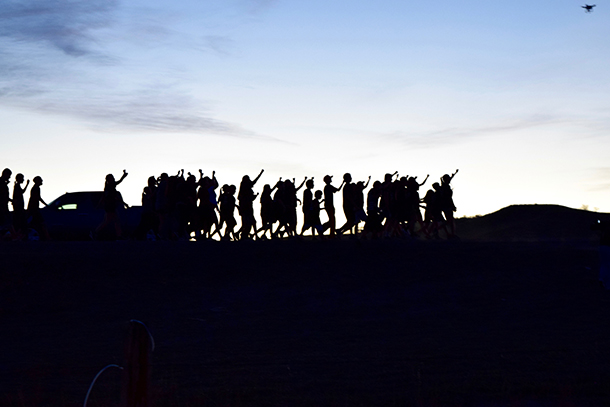
A group of youth demonstrators marching from Cannonball River to the Oceti Sakowin Campground. (Photo: Jacqueline Keeler)
CURWOOD: So the state is determined, and on the other hand, seems that the Standing Rock Nation seems to have garnered support from all over the world. How correct is that? Where are they coming from and why?
TOLAN: Well it’s true. People have come from all over the world, certainly from all over the US. One of the most striking things I’ve seen in a long time, Steve, is walking down the main so-called road of the largest encampment. That main road is called Crazy Horse Avenue. And you look on either side, and there are tents for food donations, there's a mess hall, there’s food storage area, clothing donation area. There's an elementary school.
Most striking is the 300 tribal flags that line Crazy Horse Avenue. People have come as far as away as Central America even, Native people of Norway have come, and from all over the US. And I spoke with another Native American journalist, who grew up in North Carolina identifying more with the African American side than the Seminole side of the past. But when she heard about what was happening at Standing Rock, she felt compelled to go there. This is Rose Davis.
DAVIS: I just felt that the ancestors were, you know, drawing me here. I feel comfortable here. And it's one of the most refreshing healthy atmospheres that I’ve breathed in some time. There's a lack of corporate feeling here. There's nothing for sale, you know. There's a kindness, gentleness, and gentle embrace of what I consider to be the spiritual aspect of being a human being.
CURWOOD: So, how important is this? How important is this to the native folks there in terms of protecting the environment?
TOLAN: I spoke to a couple of very thoughtful people from the Indigenous Environmental Network, Tom Goldtooth and Kandi Mossett. They’re a big part of the so-called “keep it in the ground” movement, which has spearheaded a lot of the climate-change opposition to both the Keystone XL and Dakota Access pipelines. Mossett told me, first of all, that the Dakota pipeline “would increase emissions by the equivalent of 29.5 new coal fired power plants per year, or the equivalent of 21.4 million more vehicles on the road per year”.
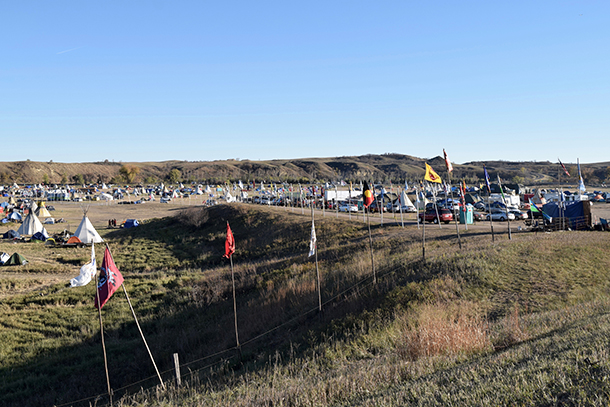
Flags from various tribes line Crazy Horse Avenue, the main road of the Oceti Sakowin resistance camp. (Photo: Jacqueline Keeler)
But she also described a vision for alternatives to massive pipeline projects, to transition from a fossil fuel economy into more of a renewable economy. And she said examples could start right there, this winter at the camp near Standing Rock, with people donating solar power and wind power and earth lodge building and long house building and wigwam building materials, and even tiny houses.
Tom Goldtooth shared more of a global, spiritual vision with me. He said that what's happening now at Standing Rock has been long prophesied by the elders.
GOLDTOOTH: We've been told that this is going to happen. That it’s part of indigenous rising. The prophecies say that our people are going to come back around to revitalizing our language and living those original instructions that were given to us. It's not just the Native people, 5,000 people came here just a couple of weekends ago. And, you know, some of them were non-native people. We're getting support from all over the world. And they're saying, seeing something here that gives them inspiration to also re-evaluate their own relationship to their community, their relationship to their families, and really question this power construction called capitalism right now, you know.
CURWOOD: So winter is coming on and it gets cold in the Dakotas, as I understand. What happens next?
TOLAN: It sure does get cold. In the encampment which has reached a population of 5,000 during the summer there's a hard core group of about 320 who say they are planning to stay on the land throughout the winter. Now, as many people told me, it gets to 30 below, not including the wind chill in the northern plains. Of course people of the Great Sioux Nation and Lakota and Dakota people have lived in this environment for thousands of years, although not for at least the last century. So, there's a lot of concern on the part of the local community on the part in nearby Cannonball. In the camp, in the largest camp, there's plans to sort of huddle in to bring everyone closer together, to get warmer materials.
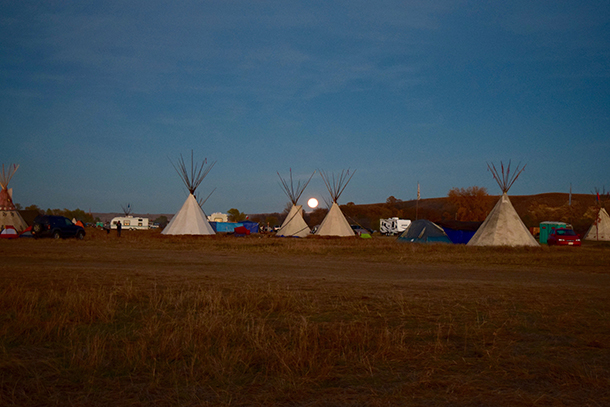
A core group of protestors has vowed to demonstrate as long as it takes to terminate the pipeline project, even if that means camping out through the harsh North Dakota winter. (Photo: Jacqueline Keeler)
There's some Inuit people in Canada who are actually shipping down teepee materials made of warm animal skins. An Oregon tribe is doing much the same. And there's an overall feeling that, one way or another, a core of resisters, of opponents to the pipeline project are going to dig in and oppose that pipeline through the winter.
CURWOOD: Reporter Sandy Tolan. Thanks so much for taking the time with us, Sandy.
TOLAN: Good to talk with you again, Steve.
Related links:
- Living on Earth’s earlier report on the legal issues of the DAPL
- KFYR TV: Extended response from Country Sherriff’s riot claims
- Democracy Now: More about protestor treatment at Standing Rock
- Journalist Sandy Tolan’s website
[MUSIC: Glen Velez, “Ramana,” from Seven Heaven, CMP Records.]
The Place Where You Live: Glacier National Park

From his perch at Siyeh Pass, Bjorn can see the Great Plains begin at the edge of Glacier National Park. (Photo: courtesy of Bjorn Beer)
CURWOOD: We stay out west and cross the border of North Dakota into Montana, for another installment in the occasional Living on Earth/Orion Magazine series, “The Place Where You Live.” Orion invites readers to submit essays to the magazine’s website and put their homes on the map, and we give them a voice.
[MUSIC: Edward Sharpe and The Magnetic Zeroes “Home” from Edward Sharpe and The Magnetic Zeroes (Rough Trade Records 2009)]
CURWOOD: The special place that inspires essay writers doesn’t have to be breathtaking or awe-inspiring, but today it is.
BEER: My name is Bjorn Beer, and this is my essay on Glacier National Park.
Last summer I stood with my wife on the edge of a sheer cliff in Glacier National Park. We stared down towards the massive Grinnell Glacier. In that moment we decided to move to Montana. I can work anywhere with internet, and my wife had multiple job offers at hospitals across the country. We could have picked anywhere, but we decided to make this remote region our home, the center of our universe.

Freya and Mom taking the first steps on a steep side trip up to Swiftcurrent Pass. (Photo: Bjorn Beer)
[MUSIC: UNDER BEER’S NARRATION: BRIAN ENO, “ARAGON,” MUSIC FOR FILMS, https://www.youtube.com/watch?v=q5VIJor61uM]
As a writer, I’m surprised that I can’t find the exact words to explain why we chose to live in the Flathead Valley. Perhaps it’s the fact we’ll be on the largest freshwater lake west of the Mississippi, a definite advantage as the West becomes hotter and drier. Or maybe the proximity to the raw, jagged beauty of Glacier Park lifts my soul. Perhaps we were just drawn to the great skiing, hoping our daughter can experience this privileged pastime, as the autumn lingers longer, and spring accelerates bit by bit, year by year. I can’t tell you one rational reason why we chose Montana, so perhaps the rationale lies deeper, in emotion, in loss.
By the year 2030, all of these glaciers will be gone.
[SOUNDS OF TRICKLING WATER MIX WITH MUSIC UNDER BEER’S NARRATION: BRIAN ENO, “ARAGON,” MUSIC FOR FILMS, https://www.youtube.com/watch?v=q5VIJor61uM]
Blackfoot, Jackson, Sperry, Swiftcurrent, Grinnell, and dozens more. Their stately names will disappear as they melt and flow into the sea. Perhaps there is some guilt here, like the way we might not see a relative for years, but once she is on her deathbed, we feel compelled to visit, to commune, to see her before she loses her earthly form.
I want to be there as they melt. I want to hike back to Grinnell Glacier with my then teenage daughter in the year 2030 as the last sliver of ice sublimates into human memory. I will want to say, “I’m sorry.” I will want to say, “We tried.”
We were here last summer on an interview that my wife had here at the hospital. She was looking for jobs around the country, and we went up into the park on a very epic hike called the Highline trail. It starts off at a high pass.

Bjorn, Amanda, and Freya Beer headed along the scenic Highline Trail en route to a night in the backcountry. (Photo: courtesy of Bjorn Beer)
[SOUND OF FOOTSTEPS]
And we ended hiking up to this ridge that overlooked this glacier, and it was just a tremendous experience. Climbing up this scree field, just a bunch of small stones that are a little bit hard footing on, a steep, steep trail up, you climb and climb for about 45 minutes, and the view that surprises you on the other side, you’re not expecting it but you can see Grinnell glacier a couple thousand feet below you and it just takes your breath away. It's this glacier that is calving off into Grinnell Lake. The water is this very bright, bright blue. It's just this amazing turquoise that provides this very stark contrast against the white glacier on these very dark cliffs, blue sky that, of course, we're in big sky country so you can see pretty far.
[MUSIC UNDER NARRATION CONTINUES]
What I love about wilderness like this is it so humbling, and Glacier Park in particular is exceptionally humbling because you have these very large animals that can potentially eat you, and the weather is incredibly extreme here, so you have to be prepared for anything, even a day hike you have to be prepared. We tried to hike up to the same overlook a couple weeks ago with our daughter, she's three-and-a-half and she was riding on my back.
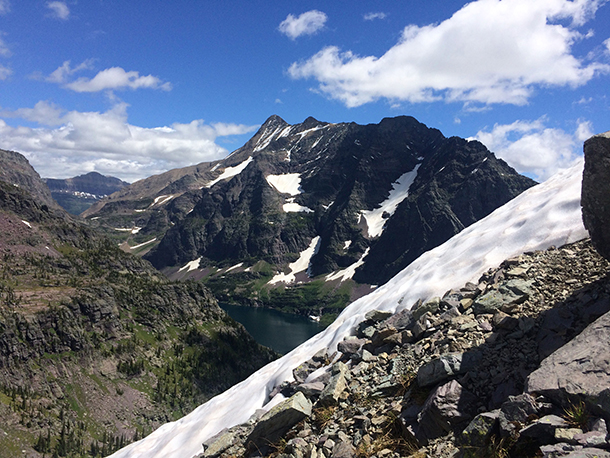
View from Lincoln Peak of glaciers on west side of Mount Jackson, which feed Lake Ellen Wilson. Permanent snowfield in foreground was used to test out Bjorn's new ice axe. (Photo: Bjorn Beer)
[SOUNDS OF THUNDER]
On the way to this hike, we couldn't actually summit because of a lightning storm, so we turned back around and stayed at a chalet that night and the next day we said, “Let's go up and show our daughter the Grinnell Glacier Overlook.” And there was a grizzly sow and its cub that were on the trail head up to this overlook so we ended up having to walk out with a ranger to avoid the grizzly.
[MUSIC CONTINUES UNDER NARRATION.]
It's hard to wrap your mind around when you're standing next to or above this glacier that in just a few decades it might be gone in the blink of an eye. Back in the 1800s, there were about 150 active glaciers. Today it's down to 25. Some people are saying that by the year 2030 all of these glaciers will be gone. At this northern latitude and with the glaciers, we're seeing the effects of climate change happen much faster in this part of the world. You do feel like you're almost a canary in a coal mine living here.
[TALKING TO HIS DAUGHTER] What we're going to do here, Freya, is we're going to record your beautiful song so that I can learn to sing.
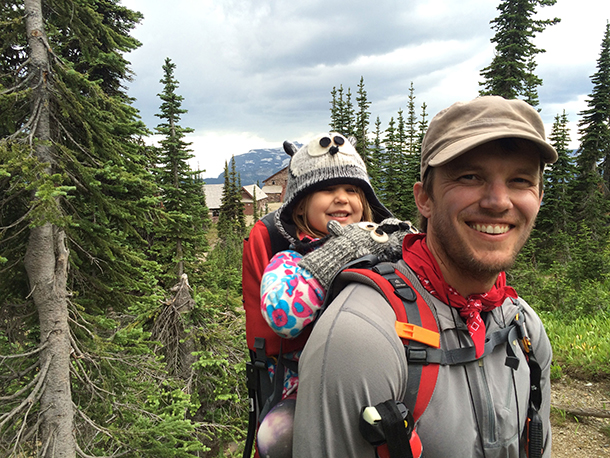
Bjorn and Freya Beer climbing up to Swiftcurrent Pass from the backcountry Granite Park Chalet in Glacier National Park. (Photo: courtesy of Bjorn Beer)
FREYA: OK. [SINGS] The Earth is good to me, and so I thank the Earth for giving me the things I need, the sun and the rain and the appleseeds. The Earth is good to me.
[MUSIC: "Johnny Appleseed," Instrumental piano recording arr. Bernie Cossentino for SongsForTeachers ]
CURWOOD: That’s Bjorn Beer’s three year old daughter, Freya, and his essay on Grinnell Glacier. There are pictures at our website, LOE.org, and there you’ll also find details about Orion Magazine and how to submit your essay, if you want to tell us about the place where you live.
Related links:
- The melting of Glacier National Park’s glaciers
- National Geographic Video: Photo Evidence: Glacier National Park is Melting Away
- Bjorn Beer’s writing for Earth Island Journal
Coming up...how the lowly and ubiquitous urban pigeon could give useful clues for human health. That’s just ahead here on Living on Earth. Stay tuned.
ANNOUNCER: Funding for Living on Earth comes from you our listeners, and United Technologies - combining passion for science with engineering to create solutions designed for sustainability in the aerospace, food refrigeration and building industries. UTC companies such as Otis, Carrier, Pratt & Whitney and UTC Aerospace Systems are helping to move the world forward.
This is PRI, Public Radio International.
[CUTAWAY MUSIC: Natraj, “Avo Matodzo,” from Meet Me Anywhere, West African traditional, arr. Scarff, Dorian Discovery]
Science Note: Pigeons Flag Lead Pollution

According to the Chemosphere study, feral pigeons could be important bioindicators for lead exposure. (Photo: Razvan Socol, Wikimedia Commons CC BY-SA 3.0)
CURWOOD: It’s Living on Earth, I’m Steve Curwood. In a minute, don’t be deceived by the purring. Your kitty has the heart and instincts of a lion. But first this note on emerging science from Jay Feinstein.
[SCIENCE NOTE THEME]
FEINSTEIN: Exposure to the toxic metal lead, even at low levels, has been shown to affect intelligence, brain development, and social skills in children.
But lead doesn’t only affect humans. A recent study published in the journal Chemosphere assessed pigeons in New York City as possible indicators of environmental lead levels, since they share our roads, breathe our air, and eat our food.
Scientists tested blood lead levels of 825 visibly ill pigeons identified by citizen scientists in various New York City neighborhoods. In many areas, levels of lead in the pigeons correlated with the average rates of blood lead in children reported by the health departments.
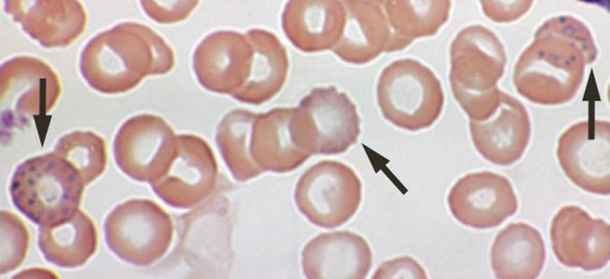
Basophilic stippling in red blood cells in an individual with elevated blood levels (Photo: Herbert L. Fred, MD and Hendrik A. van Dijk, Wikimedia Commons CC BY 2.0)
For example, both children and pigeons exhibited higher lead levels in areas such as Soho and Greenwich Village and lower levels in Harlem. The study suggests that this may be due to traffic density.
The study also found higher levels in the summer in both children and pigeons, perhaps related to more summer activity outside, or frozen snowy ground in winter making toxins less accessible.
The scientists note that monitoring pigeon lead levels will help us understand where the neurotoxin’s found, and suggest better ways to prevent its damage.
That’s this week’s note on Emerging Science. I’m Jay Feinstein.
[SCIENCE NOTE THEME]
Related links:
- The study, “Seasons and neighborhoods of high lead toxicity in New York City: The feral pigeon as a bioindicator”
- Lead poisoning fact sheet
- Article in the journal Nature on bioindicators
The Lion in the Living Room
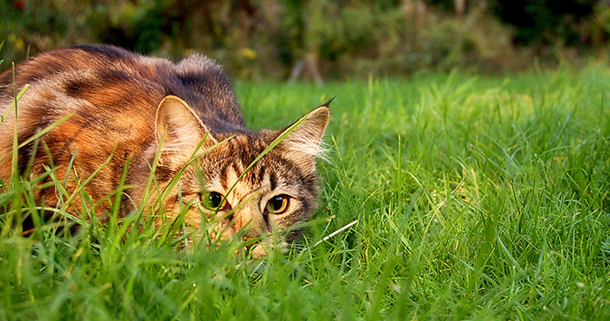
Even as they’ve comfortably moved into domestic life, cats haven’t compromised too much of their self-sufficiency – they still have the ability to hunt in the wild as feral cats. (Photo: Jennifer Barnard, Wikimedia Commons CC BY 2.0)
CURWOOD: The world has plenty of cat lovers, and here in the US, housecats outnumber dogs three to one, which seems a bit counterintuitive, considering that Fluffy doesn’t seem to give us the unconditional adoration we get from Ruff. But Abigail Tucker says there’s a reason why cats came to rule the roost, and, she says, they really do rule the roost. We didn’t tame them. They tamed us.
That’s the subtitle of her new book “The Lion in the Living Room.” Abby, welcome to Living on Earth.
TUCKER: Thank you so much for having me.
CURWOOD: Yes, your book is called the "The Lion in the Living Room: How House Cats Tamed Us and Took Over the World".
TUCKER: That's right.
CURWOOD: So, exactly how much of a success story is that of the modern house cat?
TUCKER: It's really kind of a staggering success story because there's at least 600 million and some people think closer to a billion house cats on the planet today which is a shocking number for an animal of any kind. It's especially shocking, though, because house cats are, of course, felines. In nature, felines are relatively rare because they tend to sit atop whatever ecosystem they're in, and they have these huge protein requirements that they have to satisfy, so they're actually rarer than other kinds of carnivores typically, and in the modern age the feline family has been in a lot of trouble because basically they clash with people over meat. And so it's even more spectacular that house cats have been able to carve out a global spot for themselves when so many of their wild relatives, from tigers to sand cats to pretty much any other member of the feline family, have come on hard times in recent years because of their long-standing animosity with man basically.
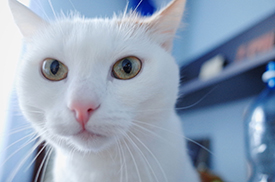
Cats were originally attracted to human settlements – especially our trash. (Photo: Anton, Flickr CC BY 2.0)
CURWOOD: So, what's the secret of success for the house cat and the role of humans in that?
TUCKER: Well, basically house cats have been able to succeed by sidling up to humanity and harvesting our resources without giving us too much in return and also without compromising their feline forms in a way that would prevent them from surviving without us. Cats have undergone this very interesting and complicated process of domestication, but only to a degree, and they have changed the structure of their brain to get along with us better, but they haven't really changed their bodies that much, and they remain hunters as magnificent as tigers or lions or any other member of the wild feline clan.
CURWOOD: To accomplish this, how did house cats manipulate humans in their rise that they can be such huge numbers, be in our cities and you know be in our houses, or not? How did they do that?
TUCKER: Well, basically, the story goes back about 10,000 years ago to the first permanent human settlements that popped up in the - in the Middle East, in the near east, and basically in these settlements humans began changing the environment in really profound ways and then they started making homes and ultimately planting crops and all the things that would doom many of their wild relatives, and they, as humans, began just taking up more and more space. But rather then fighting with humans and having conflict with humans, cats, sort of lured by our trash came closer and closer into our settlements and started changing themselves to get along with the times rather been struggling against humans, basically as lions and other kinds of wild cats tend to do.
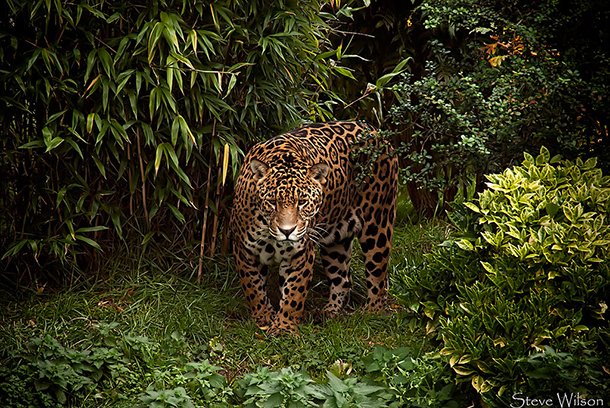
The large members of the feline family are rather uncommon in the wild, since cats require so much concentrated protein – more than 70% of a cat’s diet is meat. (Photo: Steve Wilson, Flickr CC BY 2.0)
CURWOOD: Yeah, one the things that's a little bit surprising your book, Abby, is that you say that in our society we think of cats as great for going after vermin, mice, and rats and yet at the end of the day where there more cats or more mice, there seem to be more rodents. What's going on? Cats aren't living up to this imputed bargain that I thought we had with them.
TUCKER: Yes, it's really interesting. One of the things that's kind of fascinated me about learning about cat-human relations in a more formal way is all these stories that we kind of make up to make excuses for cats and to explain why we have these animals around and, of course, the classic story is that these animals are very important for vermin control.
Scientists from Johns Hopkins have had this ongoing rodent ecology project going on for maybe 50 years, and they basically have been hanging out with Baltimore's many rats and seeing how they live their lives in these alleyways and watching to see what impacts their ecology. And at one point in the ’80s one scientist who I met with decided to watch the effects of Baltimore's many stray cat on these alleys, and he kind of charted it out, and he found that cats do in fact live in alleyways with more rats and sort of the cat excuse for that would be, oh, that's because they're bravely killing out these rats which are so harmful to human health. But actually what he found was that cats and rats do not fight in these environments at all and that they are more or less peacefully sharing another resource which is trash.
CRWOOD: So, in other words, the Hanna Barbera cartoon series Tom and Jerry, the cat Tom never catches the mouse. This is the reality.
TUCKER: [LAUGHS] Yes, That's exactly the reality.
CURWOOD: You make it sound like, in some respects cats are rats with fur that purr.
TUCKER: [LAUGHS] That's really interesting. I mean, scientists do you think of them, as the pathway that they followed to come and live with us in our settlements, in our cities…Scientists do think of them almost more as animals like rats or pigeons that became affiliated with people without ever really coming under their control.
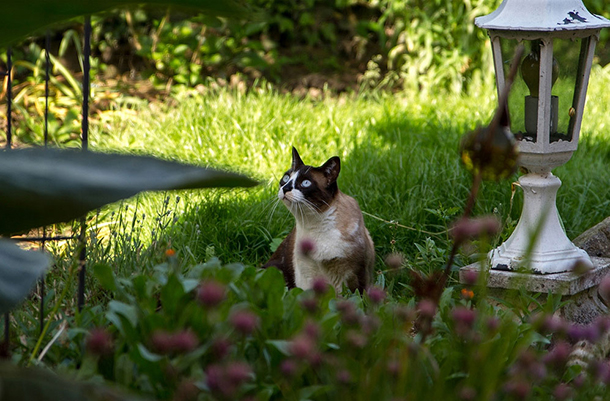
Cats are highly adaptable and can live in a wide variety of environments (Photo: Michael Frank Franz, Flickr CC BY 2.0)
CURWOOD: Now, you know, one of the takeaways from your book is the sheer scope of the cat population, this big rise over the last few decades, and then the feral cat population across the globe. I think you write that in the US there are as many wild or feral cats as house cats, and in Australia it's like a six-to-one ratio of feral cats to house cats. So what's the genetic difference between feral cats and house cats, or is this strictly a matter of upbringing?
TUCKER: Yeah, I mean that's one of the really interesting things. We tend to classify these animals as different, very different in our minds and think of the stray cats as being wilder and in some ways different than our very pampered house pets, but actually, genetically they're exactly the same animal. I talked to scientist who studies, who’s an expert in carnivores and he was doing a study in Madagascar and studying a different kind of animal, and he begin catching these cats in his traps and they were so big and so fierce and so formidable that he actually ran genetic tests on them to ascertain that they were in fact just regular house cats that had been living in the Madagascar interior for, you know, maybe a couple of hundred years but genetically they're just the same kinds of cats as we have in our own homes, which is kind of spectacular. It's this idea that cats can... They're so incredibly adaptable that they can make a go of it in a studio apartment or patrol thousands of acres in the middle of the woods and do fine in either environment.
CURWOOD: Now, you say there are about a billion cats around the planet. How many birds do these cats kill in a given year?
TUCKER: You know, right, so that would be a billion cats - owned pets as well as strays - and the estimates that we get from federal scientists are that these cats kills billions of songbirds per year and also wreak havoc on small mammal populations, and they also kill plenty of amphibians and even insects. But it's also interesting just to think about where the food in your cat's canned food comes from as well. I mean, the fascinating thing about cats and what makes them such unusual candidates for being a globally invasive species is that they're what's called hyper-carnivores, so that means that more than 70 percent of their diet is meat.
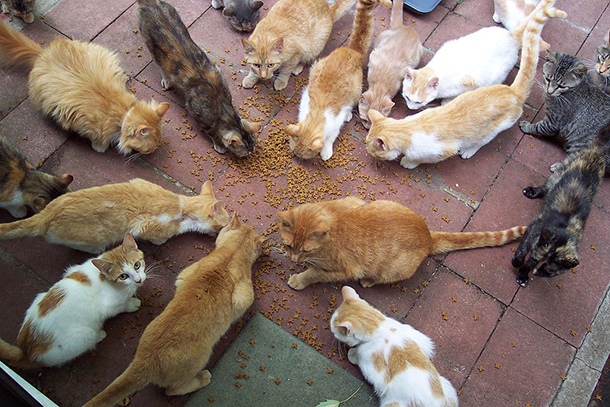
Cat lovers who look for strays will find plenty eager to be fed. (Photo: Scott Granneman, Wikimedia Commons CC BY-SA 2.0)
Cats basically eat meat and nothing else, so whether they're going out your garden and hunting a chipmunk or eating something that they get in a can, which could be a wild sardine caught in a far off ocean or a chicken raised a farm somewhere, all these things are meat, and all these things have an environmental impact. So, in a way I think it's a little limited to just think of, “OK, well, my cat is inside so it doesn't eat any wild animals.” That's important, and that's good, but it's not that your cat is existing on, you know, on air and water alone. You know, these animals eat things, and the fact that they do take a toll on the environment and on human resources only makes it more interesting that we tolerate them and even encourage having huge numbers of them around.
CURWOOD: Looking ahead at how cats might involve. What are the indications for what future house cats might look like given their pace of evolution?
TUCKER: Yeah, that's a really interesting question. So, basically one of the things that I learned when reporting this book is that so far humanity has really had no intentional impact on the way that house cats look or behave. We've influenced them certainly because they sort of came to be because of our settlements, but we never exerted any intentional control over these animals, and that continues today.
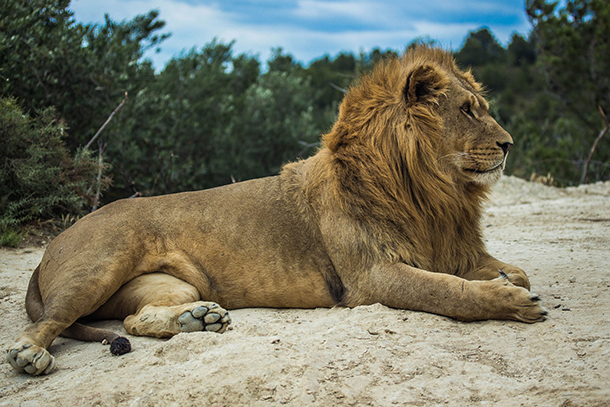
Felidae is a diverse taxonomic family that includes lions as well as house cats. (Photo: Pauline Guilmot, Flickr CC BY 2.0)
So, you'll see these animals, like I mentioned the scientists who discovered an unknown population of marooned house cats in interior Madagascar, which is not a place where cats normally occur. Those had been deposited by sailors at some points in human history, and those animals were like really big burly house cats with very kind of striped camouflaged looking coats that were making a living for themselves in the wild. And so that's one direction that house cats can go, and becoming almost more lion-like in the way that they look and act if they are reverting to a more wild environment.
At the same time, though, that's not really the evolutionary pressure that's on cats right now. Basically humans are just becoming a bigger and bigger global force, and really where the pay-dirt is, is still in our settlements and living closely with us, and that set of factors does not favor the cats that are big and strong and burly and good at fighting. It actually favors tame cats and meek cats that are able to get into our settlements and live in high densities and not fight so much but have as many babies and eat as much food as they possibly can. And so that's the cat that the 21st century belongs to. While cats can still hack it in the wilderness, the human settlements are really kind of where the future is at, and I think the only way that we as humans have really collectively influenced the feline phenotype, as far as I can tell, is by how fat cats have become as a population, not just our house pets which are frequently in a morbidly obese state, even stray cats and other animals that live in our settlements are really growing larger in a way that doesn't have to do with muscles necessary, but is more just kind of chubbiness.
CURWOOD: Hmmmm, our civilization promotes the fat cat, huh?
TUCKER: [LAUGHS] Yeah, it really does.
CURWOOD: Not just limited to felines, I gather. Hey, on a more personal note, Abby, how did the process of writing "Lion in the Living Room" change how you feel towards cats?
TUCKER: Well, that's an interesting question. I had always been a cat person, and I grew up with cats, and my mom grew up with cats, and it's just been kind of a familial trait, and I still think of myself very much as a cat person. But I don't think that I necessarily gave cats credit for what amazing and formidable animals that they are, even though I write about animals in a professional way and have gone to different places around the world to write about different rarified creatures in their native environment. I was just as guilty as the next person when it came to looking at my cats as little, cute little fur babies and infantilizing them and pretending that they needed help from me.

Abigail Tucker is a self-described “cat person” (Photo: courtesy of Simon & Schuster Publishing)
Now I understand that you know even though I been accustomed to traveling across the world looking for interesting animals, this is an interesting animal that has come to meet me in my living room. This creature is a creature of conquest and a creature that is a global survivor and is sort of an example of how amazing nature is. And I think that in a way, you know, that's a lot more kind of stimulating and interesting than thinking of my cat is just being a kind of slow-witted, furry human, which is how I used to think about them.
CURWOOD: Hmmmm...they're not so slow-witted are they?
TUCKER: They're really not.
CURWOOD: Abigail Tucker's book is called “The Lion in the Living Room: How House Cats Tamed Us and Took Over the World". Thanks, Abby, for taking the time today.
TUCKER: Thank you so much for having me.
Related links:
- Abigail Tucker’s website
- The Lion in the Living Room book
- The American Bird Conservancy’s official statement about the threat of housecats to wildlife
- Official website for Alley Cat Allies, a cat advocacy group
BirdNote: Swallows in Winter
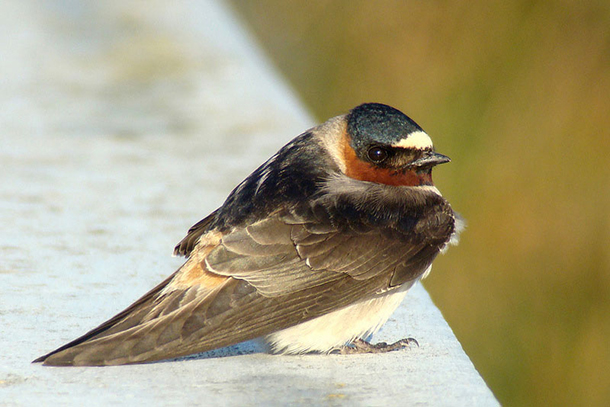
Cliff swallow (Photo: Maggie Smith)
[MUSIC: BIRDNOTE® THEME]
CURWOOD: The changing seasons bring special joys such as colorful leaves, and the luscious apples of autumn. But as Michael Stein points out in today's BirdNote®, there’s also a sense of loss when we bid farewell to one of the most beloved signs of summer.
BirdNote®
Where Swallows Go in Winter
[Calls of Barn Swallows]
Are any birds more conspicuous by their absence than swallows? Through all of spring and summer, swallows dart and sail overhead, their airborne grace a wonder to behold. [Continue Barn Swallows]
So while October marks a lovely juncture in the change of seasons, the skies seem empty. The swallows have flown south.
Swallows feed almost exclusively on flying insects, abundant in the warmer months, scarcer as fall takes hold. The swallows – eight species nest in the United States – must fly south for the winter, to latitudes where aerial insects are to be found.
[Song of Tree Swallow]
So, if you wanted to follow the swallows in winter, where would that journey take you? [Violet-green Swallow runs in background] Well, to catch up with Violet-green and Tree Swallows, you would traverse much of Central America. A search for the other six species would take you through much of South America. Indeed to see Cliff Swallows, you would have to strike off as far south as Argentina. [Calls of Cliff Swallow colony]
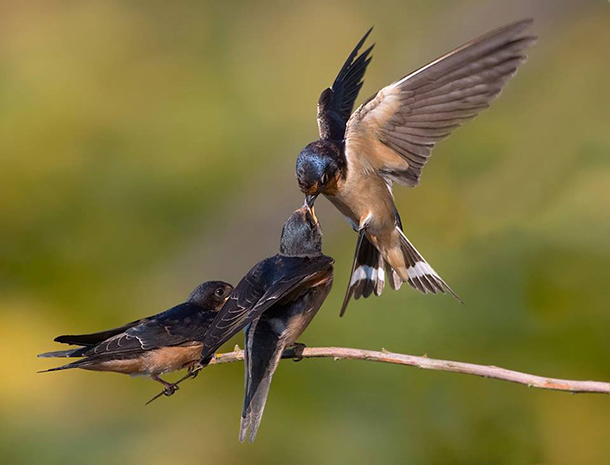
Feeding juvenile barn swallows (Photo: Tom Sanders)
For a parting look at swallow flocks in early October, visit the sort of places they concentrate before migrating. Check around large open fields or pastures, or wetlands like marshes or ponds – for a last chance to say farewell until next March or April.
[Continue Barn Swallows]
I’m Michael Stein.
###
Written by Bob Sundstrom
Bird audio provided by The Macaulay Library of Natural Sounds at the Cornell Lab of Ornithology, Ithaca, New York. Barn, Violet-green and Cliff Swallow recorded by G.A. Keller. Tree Swallow recorded by G.F. Budney.
Producer: John Kessler
Executive Producer: Chris Peterson
© 2005-2016 Tune In to Nature.org October 2016 Narrator: Michael Stein
http://birdnote.org/show/where-swallows-go-winter
CURWOOD: Swoop on over to our website, LOE.org for some pictures.
Related links:
- The story on the BirdNote website, “Where Swallows Go in Winter”
- More about Cliff Swallows on All About Birds from the Cornell Lab of Ornithology
- More about the swallow family on All About Birds from the Cornell Lab of Ornithology
[MUSIC: Harper Tasche, “Featherspirit,” from Provenance, Harp Crossing Records and reissued with permission on Oasis: Classical & Instrumental, Volume VIII #2, Oasis Disc Manufacturing]
CURWOOD: Living on Earth is produced by the World Media Foundation. Our crew includes Naomi Arenberg, Bobby Bascomb, Aidan Connelly, Savannah Christiansen, Jenni Doering, Emmett Fitzgerald, Jaime Kaiser, Don Lyman, Alex Metzger, Helen Palmer, Adelaide Chen, Jennifer Marquis and Jolanda Omari. Tom Tiger engineered our show, with help from Jeff Wade, Jake Rego and Noel Flatt. Alison Lirish Dean composed our themes. You can hear us anytime at LOE.org, and like us, please, on our Facebook page, PRI’s Living on Earth. And we tweet from @livingonearth.
I'm Steve Curwood. Thanks for listening.
ANNOUNCER1: Funding for Living on Earth comes from you, our listeners, and from the University of Massachusetts, Boston, in association with its School for the Environment, developing the next generation of environmental leaders. And from the Grantham Foundation for the protection of the environment, supporting strategic communications and collaboration in solving the world’s most pressing environmental problems. Support also comes from the Energy Foundation, serving the public interest by helping to build a strong, clean, energy economy, from Gilman Ordway, and from SolarCity, America’s solar power provider. SolarCity is dedicated to revolutionizing the way energy is delivered by giving customers a renewable alternative to fossil fuels. Information at 888-997-1703. That’s 888-997-1703.
ANNOUNCER2: PRI. Public Radio International.
Living on Earth wants to hear from you!
Living on Earth
62 Calef Highway, Suite 212
Lee, NH 03861
Telephone: 617-287-4121
E-mail: comments@loe.org
Newsletter [Click here]
Donate to Living on Earth!
Living on Earth is an independent media program and relies entirely on contributions from listeners and institutions supporting public service. Please donate now to preserve an independent environmental voice.
NewsletterLiving on Earth offers a weekly delivery of the show's rundown to your mailbox. Sign up for our newsletter today!
 Sailors For The Sea: Be the change you want to sea.
Sailors For The Sea: Be the change you want to sea.
 The Grantham Foundation for the Protection of the Environment: Committed to protecting and improving the health of the global environment.
The Grantham Foundation for the Protection of the Environment: Committed to protecting and improving the health of the global environment.
 Contribute to Living on Earth and receive, as our gift to you, an archival print of one of Mark Seth Lender's extraordinary wildlife photographs. Follow the link to see Mark's current collection of photographs.
Contribute to Living on Earth and receive, as our gift to you, an archival print of one of Mark Seth Lender's extraordinary wildlife photographs. Follow the link to see Mark's current collection of photographs.
 Buy a signed copy of Mark Seth Lender's book Smeagull the Seagull & support Living on Earth
Buy a signed copy of Mark Seth Lender's book Smeagull the Seagull & support Living on Earth

